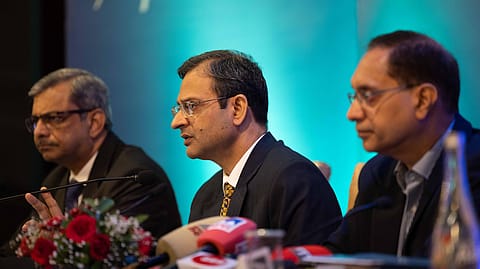Sanjay Malhotra’s challenge: Inflation vs growth trade-off
The new RBI governor faces a complex economic landscape.

For someone who was seen in sync with the current dispensation, especially given that Shaktikanta Das presided over a generous dole out of ₹2.98 lakh crore as record dividend to the government, the appointment of revenue secretary Sanjay Malhotra as the 25th governor of the Reserve Bank of India (RBI) came as a surprise.
Malhotra steps into the role of the governor at a crucial juncture, facing challenges reminiscent of Raghuram Rajan’s tenure, yet layered with new complexities. While inflation remains stubbornly high at 6.21% in October, GDP growth is faltering, projected to slow to 6.6% for FY24-25 from what the central bank had forecast 7.2% growth in October. Against this backdrop, the calls for lower interest rates from key ministers in the Narendra Modi government have added a political undertone to an already fraught situation.
Both Union Finance Minister Nirmala Sitharaman and Commerce Minister Piyush Goyal have publicly flagged high interest rates as a growth dampener. “At a time when we want industries to ramp up and build capacities, our bank interest rates will have to be far more affordable,” Sitharaman had remarked at a recent event, underscoring the political and economic pressure on the RBI to shift its stance. Goyal echoed this sentiment, calling for rate cuts and arguing that food inflation should not overly influence rate decisions.
This interplay between fiscal authority and monetary independence places Malhotra in a challenging position.
A Tougher Trade-off
When Rajan took over as the governor in September 2013, India was grappling with soaring inflation of 10.7%, a volatile rupee, and global turbulence in the wake of the U.S. Federal Reserve’s “taper tantrum.” Despite political and market pressures, Rajan prioritised inflation control over short-term growth, hiking the repo rate to 8% within months from 7.5% when he took over. His decisive actions, coupled with the introduction of an inflation-targeting framework, curbed inflation from double digits to 5.76% by the end of his term.
Malhotra, however, inherits a more nuanced dilemma. The repo rate has been steady at 6.5% for eleven consecutive meetings, signalling the RBI's caution amid persistent inflation and slowing growth. High food prices and sticky core inflation complicate his ability to loosen policy without undermining the RBI’s inflation-targeting credibility.
Recommended Stories
The global economy is fragile amid rising geo-political tensions, and India’s recovery from the pandemic remains uneven. Aggressive rate hikes could choke nascent growth, while inaction could erode confidence in the RBI’s commitment to control inflation, which is hovering over 6%.
Malhotra’s policy toolkit may include unconventional measures such as tweaking the cash reserve ratio, open market operations, or targeted liquidity injections to support growth while managing inflation. Coordination with fiscal policy will also be critical to address structural supply-side issues, particularly in agriculture, where food price volatility remains a key driver of inflation.
Malhotra’s recent remarks as revenue secretary offer a glimpse into his economic thinking. He had cautioned GST tax officials over aggressive policing that harm long-term economic interests for short-term gains, cautioning, “We are here not only for revenue [collection for the exchequer], we are here also for the country’s economy. And so, if in the process of garnering some small amount of revenue, we are hurting the whole industry and the country’s economy, then certainly, that is not the intent,” he was quoted as saying in a news report.
This approach highlights a likely emphasis on economic growth and stability over knee-jerk reactions to either inflationary pressures or political demands. Balancing these priorities, however, will require deft navigation, especially as the government calls for rate cuts to spur growth.
(INR CR)